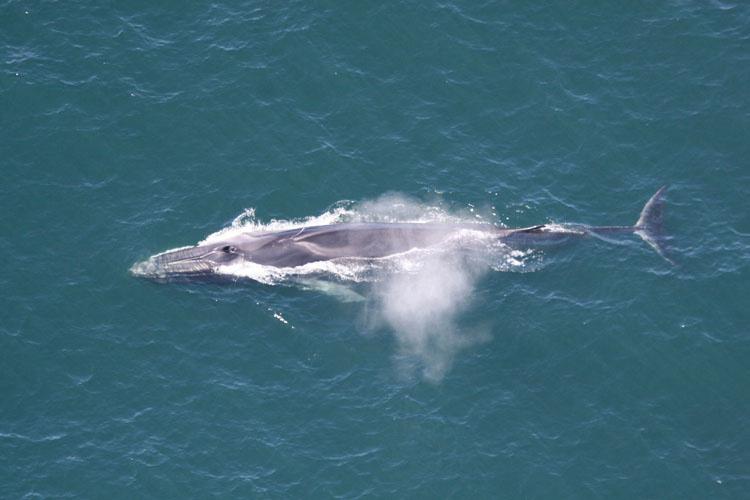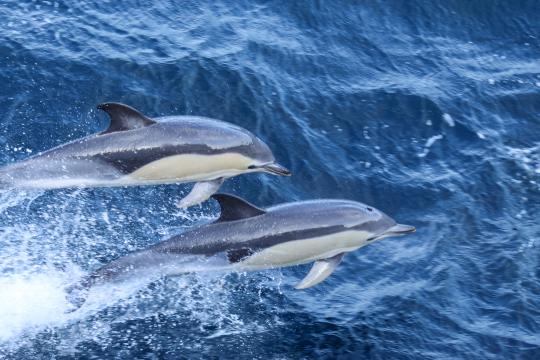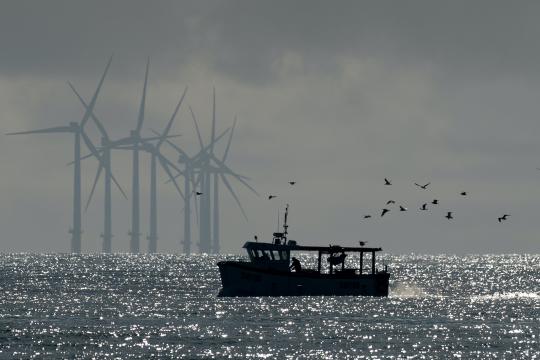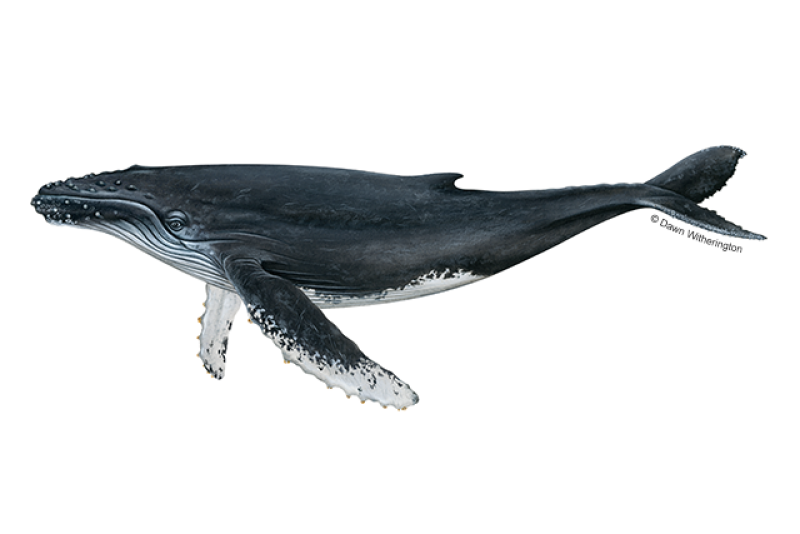Fin Whale
Balaenoptera physalus

Protected Status
Quick Facts
 Fin Whale. Credit: NOAA Fisheries
Fin Whale. Credit: NOAA Fisheries
Fin Whale. Credit: NOAA Fisheries
About the Species
 Fin Whale. Credit: NOAA Fisheries
Fin Whale. Credit: NOAA Fisheries
Fin Whale. Credit: NOAA Fisheries
The fin whale is the second-largest whale species on earth, second only to the blue whale. It is found throughout the world’s oceans. It gets its name from an easy-to-spot fin on its back, near its tail.
Like all large whales, fin whales were hunted by commercial whalers, which severely lowered their populations. Whalers did not target them at first, because they were fast swimmers and lived in open ocean habitats. But, as whaling methods modernized with steam-powered ships and explosive harpoons, and whalers decimated other easy-to-catch species, whaling turned to fin whales. This industry killed a huge number during the mid-1900s—nearly 725,000 in the Southern Hemisphere alone.
Whaling is no longer a threat for fin whales (commercial whaling ended in the 1970s and 1980s, though some subsistence hunting continues today in Greenland under sustainable quotas allowed by the International Whaling Commission). Currently, the major threat to this species comes from vessel strikes. The fin whale is listed as endangered under the Endangered Species Act and depleted under the Marine Mammal Protection Act.
NOAA Fisheries and its partners are dedicated to conserving and rebuilding fin whale populations. We use innovative techniques to study, protect, and rescue these endangered whales. We engage our partners as we develop regulations and management plans that foster healthy fisheries and reduce the risk of entanglements, create whale-safe shipping practices, and reduce ocean noise.
Population Status
For management purposes, we divide fin whales in U.S. into four stocks:
- California/Oregon/Washington
- Hawaii
- Alaska (Northeast Pacific)
- Western North Atlantic
We determine the number of fin whales through counting stocks, however, not all stocks have accurate information. Reliable, recent estimates are available for much of the North Atlantic Ocean, but not for most of the North Pacific or the Southern Oceans. We do not know how populations in those ocean basins have changed, relative to their pre-whaling size. The most recent population assessments can be found in stock assessment reports.
Appearance
Fin whales have sleek, streamlined bodies with V-shaped heads. They have a tall, hooked dorsal fin, about two-thirds of the way back on the body, that rises at a shallow angle from the back. Fin whales have distinctive coloration—black or dark brownish-gray on the back and sides and white on the underside. Head coloring is asymmetrical—dark on the left side of the lower jaw, white on the right-side lower jaw, and the reverse on the tongue. Many fin whales have several light-gray, V-shaped “chevrons” behind their heads; on many of them, the underside of the tail flukes is white with a gray border. These markings are unique and can be used to identify Individual fin whales.
Behavior and Diet
Fin whales are fast swimmers and are often found in social groups of two to seven individuals. In the North Atlantic, they are often seen feeding in large groups that include humpback whales, minke whales, and Atlantic white-sided dolphins.
During the summer, fin whales feed on krill, small schooling fish (including herring, capelin, and sand lance), and squid by lunging into schools of prey with their mouth open, using their 50 to 100 accordion-like throat pleats to gulp large amounts of food and water. They then filter the food particles from the water, using the 260 to 480 baleen plates (long, flat plates made of fingernail-like material called keratin) that they have in place of teeth on each side of the mouth. Fin whales fast in the winter while they migrate to warmer waters.
Like other baleen whales, fin whales also skim the water, taking in huge volumes of water. When they close their mouths, the water is pushed out through the baleen and the prey is caught on the inside of the baleen. A fin whale eats up to 2 tons of food daily.
Where They Live
Fin whales are typically found in deep, offshore waters of all major oceans, primarily in temperate to polar latitudes. They are less common in the tropics. They occur year-round in a wide range of locations, but the density of individuals in any one area changes seasonally. Most migrate from the Arctic and Antarctic feeding areas in the summer to tropical breeding and calving areas in the winter. The location of winter breeding grounds is not known. Fin whales travel in the open seas, away from the coast, so they are difficult to track. There are three named subspecies of fin whale:
- B. physalus physalus in the North Atlantic and North Pacific
- B. physalus quoyi in the Southern Ocean
- B. physalus patachonica in the mid-latitude Southern Ocean
In fact, most experts consider the B. physalus physalus in the North Atlantic and the North Pacific to be separate subspecies. The two populations rarely (if ever) mix, and there are geographical stocks within these ocean basins. Fin whales are migratory, moving seasonally into and out of feeding areas near the poles, but the overall migration pattern is complex and likely varies by region, and specific routes have been documented for some populations. Acoustic recordings from passive-listening hydrophone arrays indicate a southward “flow pattern” in the fall from the Labrador-Newfoundland region, past Bermuda, and into the West Indies. There may be resident groups of fin whales in some areas, such as the Gulf of California, the East China Sea, and the Mediterranean Sea.
 World map providing approximate representation of the fin whale's range.
World map providing approximate representation of the fin whale's range.
Lifespan & Reproduction
Little is known about the social and mating systems of fin whales. As with other baleen whales, long-term bonds between individuals are rare.
Fin whales have long lives—they reach physical maturity at about 25 years, and their maximum lifespan is about 90 years. Males become sexually mature at 6 to 10 years of age and females at 7 to 12 years of age. After 11 to 12 months of gestation, a pregnant female gives birth to a single calf in tropical and subtropical areas during midwinter. Newborn calves are about 18 feet long, and weigh 4,000 to 6,000 pounds.
Fin whales sometimes mate with blue whales and hybrids have been documented.
Threats
Vessel Strikes
Vessel strikes can injure or kill fin whales. Fin whales are probably the most vulnerable species to ship strikes after North Atlantic Right Whales. The projected increase in ship traffic arising from the opening of trans-polar shipping routes (as arctic sea ice continues to decline) will increase the risk of vessel strike and also increase ambient noise and pollution.
Entanglement in Fishing Gear
Fin whales can become entangled in fishing gear, either swimming off with the gear attached or becoming anchored. They can become entangled in many different gear types, including traps, pots, or gillnets. Once entangled, whales may drag and swim with attached gear for long distances, ultimately resulting in fatigue, compromised feeding ability, or severe injury, which may lead to reduced reproductive success or death.
Ocean Noise
Underwater noise negatively affects whale populations, interrupting their normal behavior and driving them away from areas important to their survival. Increasing evidence suggests that exposure to intense underwater sound in some settings may cause some whales to strand and ultimately die.
Climate Change
The impacts of climate change on baleen whales may result from altered oceanographic conditions, as well as the timing and distribution of sea ice coverage. Changes in prey distribution could lead to changes in foraging behavior, nutritional stress, and diminished reproduction for fin whales. Additionally, changing water temperature and currents could impact the timing of environmental cues important for navigation and foraging.
Scientific Classification
| Kingdom | Animalia | Phylum | Chordata | Class | Mammalia | Order | Cetacea | Family | Balaenopteridae | Genus | Balaenoptera | Species | physalus |
|---|
Last updated by NOAA Fisheries on 11/22/2024
What We Do
Conservation & Management
NOAA Fisheries is committed to the protection and recovery of fin whales. Our work to protect and recover fin whales includes:
- Coordinating with maritime industries to advance conservation measures to protect fin whales from ship strike
- Responding to stranded and entangled fin whales
- Monitoring population abundance and distribution
- Educating the public about fin whales and the threats they face
Science
Our research projects have discovered new aspects of fin whale biology, behavior, and ecology and helped us better understand the challenges that all fin whales face. This research is especially important in rebuilding endangered populations. Our work includes:
- Taxonomy and systematics
- Stock assessments
- Measuring the response of animals to sound using digital acoustic recording tags
How You Can Help
Report Marine Life in Distress
Report a sick, injured, entangled, stranded, or dead animal to make sure professional responders and scientists know about it and can take appropriate action. Numerous organizations around the country are trained and ready to respond. Never approach or try to save an injured or entangled animal yourself—it can be dangerous to both the animal and you.
Learn who you should contact when you encounter a stranded or injured marine animal
Reduce Speed and Be on the Lookout
Vessel collisions are a major cause of injury and death for whales. Here are some tips to avoid collisions:
Be Whale Aware. Know where whales occur (habitat).
Watch your speed in areas of known marine mammal occurrence. Keep speeds to 10 knots or less to reduce potential for injury.
Keep a sharp lookout. Look for blows, dorsal fins, tail flukes, etc. However, be aware that most captains report never seeing a whale prior to colliding with it.
Protect your boat, protect your passengers. Boats can be heavily damaged and even "totalled" after colliding with a large whale. Collisions can also injure passengers.
Keep your distance. Stay at least 100 yards away.
Stop immediately if within 100 yards. Slowly distance your vessel from the whale.
Report a Violation
Call the NOAA Fisheries Enforcement Hotline at (800) 853-1964 to report a federal marine resource violation. This hotline is available 24 hours a day, 7 days a week for anyone in the United States.
You may also contact your closest NOAA Office of Law Enforcement field office during regular business hours.
Featured News
 Common dolphins. Credit: NOAA Fisheries/Michelle Klein
Common dolphins. Credit: NOAA Fisheries/Michelle Klein
Celebrating 15 Years of Surveying Protected Species in the Northwest Atlantic
 A school of northern right whale dolphins observed off Oregon on the recent Southwest Fisheries Science Center marine mammal survey. Image collected under NOAA Fisheries research permit #22306. Credit: NOAA Fisheries/Cory Hom-Weaver.
A school of northern right whale dolphins observed off Oregon on the recent Southwest Fisheries Science Center marine mammal survey. Image collected under NOAA Fisheries research permit #22306. Credit: NOAA Fisheries/Cory Hom-Weaver.
Four-Month Survey Tracking West Coast Marine Mammals Finds Some Shifting North
 Late afternoon residents walk to investigate the fin whale carcass. Credit: Bridget Crokus, volunteer Alaska Veterinary Pathology Services
Late afternoon residents walk to investigate the fin whale carcass. Credit: Bridget Crokus, volunteer Alaska Veterinary Pathology Services
 A small fishing vessel near wind turbines. Credit: Bob Brewer on Unsplash
A small fishing vessel near wind turbines. Credit: Bob Brewer on Unsplash
Studying Sound in the Ocean to Prepare for Offshore Wind Development
Management Overview
The fin whales is listed as endangered under the Endangered Species Act.
The fin whale is protected throughout its range under the Marine Mammal Protection Act.
The fin whale is depleted under the Marine Mammal Protection Act.
Additionally, the fin whale is listed under:
- Appendix I of the Convention on International Trade in Endangered Species of Wild Fauna and Flora (CITES)
- Annex II of the Protocol for Specially Protected Areas and Wildlife (SPAW)
Recovery Planning and Implementation
Recovery Action
Under the ESA, NOAA Fisheries is required to develop and implement recovery plans for the conservation and survival of listed species.
The recovery plan for the fin whale was published in July 2010. Its goal is to recover the species, with an interim goal of down-listing its status from endangered to threatened.
The major actions recommended in the plan are:
- Reduce or eliminate injury or death caused by ship collision
- Reduce or eliminate injury or death caused by fisheries and fishing gear
- Protect habitats essential to the survival and recovery of the species
- Minimize effects of vessel disturbance
- Continue the international ban on hunting and other directed take
- Monitor the population size and trends in abundance of the species
- Maximize efforts to free entangled or stranded fin whales and get scientific information from dead specimens
Learn more about the recovery plan for fin whales
Implementation
NOAA Fisheries is working to minimize effects from human activities that hinder the recovery of fin whale populations in the United States and internationally. Along with our partners, we work to:
- Reduce entanglement in fishing gear
- Respond to stranded and entangled fin whales
- Rescue collision risk to fin whales

Conservation Efforts
Reducing Entanglement in Fishing Gear
Entanglement in fishing gear is a primary cause of serious injury and death for many whale species, including fin whales.
In the Atlantic, we implemented the Atlantic Large Whale Take Reduction Plan to reduce the incidental mortality and serious injury of right whales, humpback whales, and fin whales in gillnets and trap/pot fisheries along the East Coast.
Learn more about bycatch and fisheries interactions
Reducing Vessel Strikes
Collisions between whales and large vessels can injure or kill the whales and damage the vessels, but they often go unnoticed and unreported. The most effective way to reduce collision risk is to keep whales and vessels apart. If this is not possible, second best is for vessels to slow down and keep a lookout.
Learn more about vessel strikes and marine animals
Addressing Ocean Noise
Underwater noise threatens whale populations, disrupting their normal behavior and driving them away from areas important to their survival. Increasing evidence suggests that exposure to intense underwater sound in some settings may cause some whales to strand and ultimately die. NOAA Fisheries is investigating all aspects of acoustic communication and hearing in marine animals, as well as the effects of sound on whale behavior and hearing. In 2016, we issued technical guidance for assessing the effects of anthropogenic sound on marine mammals’ hearing.
Overseeing Marine Mammal Health and Stranding Response
We work with volunteer networks in all coastal states to respond to marine mammal strandings including all whales. When stranded animals are found alive, NOAA Fisheries and our partners assess the animal’s health and determine the best course of action. When stranded animals are found dead, our scientists work to understand and investigate the cause of death. Although the cause often remains unknown, scientists can sometimes attribute strandings to disease, harmful algal blooms, vessel strikes, fishing gear entanglements, pollution exposure, and underwater noise. Some strandings can serve as indicators of ocean health, giving insight into larger environmental issues that may also have implications for human health and welfare.
Learn more about the Marine Mammal Health and Stranding Response Program
Marine Mammal Unusual Mortality Events
Fin whales have been part of a declared unusual mortality event in the past. Under the Marine Mammal Protection Act, an unusual mortality event is defined as "a stranding that is unexpected; involves a significant die-off of any marine mammal population; and demands immediate response." To understand the health of marine mammal populations, scientists study unusual mortality events.
Get information on active and past UMEs
Get an overview of marine mammal UMEs
Educating the Public
NOAA Fisheries aims to increase public awareness and support for fin whale conservation through education, outreach, and public participation. We regularly share information with the public about the status of fin whales, as well as our research and efforts to promote their recovery.
Regulatory History
Within the United States, the fin whale is listed as endangered throughout its range under the Endangered Species Act of 1973 and is listed as depleted throughout its range under the Marine Mammal Protection Act of 1972.
Key Actions and Documents
Incidental Take Authorization: Alaska Railroad Corporation's Seward Freight Dock construction project in Seward, Alaska
Incidental Take Authorization: United States Coast Guard's Base Kodiak Homeporting Facility in Kodiak, Alaska
Incidental Take Authorization: Pacific Air Forces Regional Support Center's construction activities at Eareckson Air Station Fuel Pier Repair in Alcan
Incidental Take Authorization: Scripps Institution of Oceanography's Marine Geophysical Survey in the Nauru Basin of Greater Micronesia in the NW
Last updated by NOAA Fisheries on 11/22/2024
Science Overview
NOAA Fisheries researches the biology, behavior, and ecology of the fin whale. We use the results to inform management decisions and recovery efforts for this endangered species.

Stock Assessments
Determining the number of fin whales in each population—and whether a stock is growing or shrinking over time—helps resource managers assess the success of conservation measures. Our scientists collect information and present these data in annual stock assessment reports.
Acoustic Science
Other research focuses on the acoustic environment of cetaceans, including fin whales. (Acoustics is the science of how sound is transmitted.) We study the basic acoustic behavior of whales, dolphins, and fish; map the acoustic environment; and develop better ways to find cetaceans using autonomous gliders and passive acoustic arrays.
Acoustics can reveal differences between fin whale populations and monitor hearing levels and feeding behavior. We also study how underwater noise affects the way fin whales behave, eat, interact with each other, and move within their habitat.
More Information
Recent Science Blogs
Last updated by NOAA Fisheries on 11/22/2024
Documents
Biological Opinion NOAA Fisheries, Office of Protected Resources, Permits and Conservation Division, Eareckson Air Station Long-term Fuel Pier Repairs, Shemya Island, Alaska
This opinion considers the effects of all in-water activities including vessel transit of materials…
Biological Opinion National Marine Fisheries Service, Office of Protected Resources, Permits and Conservation Division, USCG Dock Construction, Seward and Sitka, Alaska
Endangered Species Act (ESA) Section 7(a)(2) Biological Opinion for National Marine Fisheries…
Biological Opinion U.S. Army Corps of Engineers Sitka CBS GPIP Vessel Haulout Project, Sitka, Alaska
Endangered Species Act (ESA) Section 7(a)(2) Biological Opinion for United States Army Corps of…
Biological Opinion National Marine Fisheries Service, Office of Protected Resources, Permits and Conservation Division Minor Waterfront Maintenance, Repair, and Replacement Projects, Southcentral and Southeast Alaska
Endangered Species Act (ESA) Section 7(a)(2) Biological Opinion for NMFS, Office of Protected…
Data & Maps
Massachusetts Restricted Area with State Waters Expansion and Wedge Area
Research
On-Demand Gear Guide
A roadmap for providing fishermen an option to use on-demand fishing systems in the Greater Atlantic Region by 2028.
Behavioural Responses of Fin Whales to Military Mid-Frequency Active Sonar
Quantifying the factors influencing marine mammal responses to sonar, critical in assessing and…
Passive Acoustics Research Group News & Media
Our Passive Acoustics Research Group frequently makes the news. This page links to articles and other media featuring our staff and their research.
California Current Marine Mammal Assessment Program
We assess the population status of marine mammals in the California Current.
Outreach & Education
Northeast Trap/Pot Guide for Atlantic Large Whale Take Reduction Plan
Guide to Atlantic Large Whale Take Reduction Plan regulations for Northeast trap/pot fishermen…
Acoustic Studies Sound Board Of Marine Mammals In Alaska
This resource features passive acoustic sound clips of many amazing marine mammals that can be…
Large Whale Entanglement Fact Sheet
Marine mammal entanglement, or bycatch, is a global problem that results in the death of hundred of…
Last updated by NOAA Fisheries on 11/22/2024



